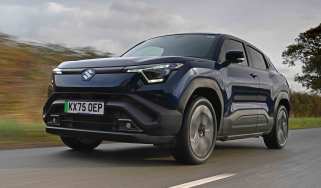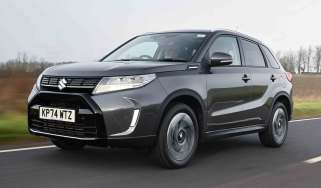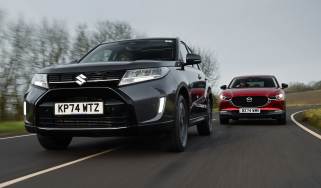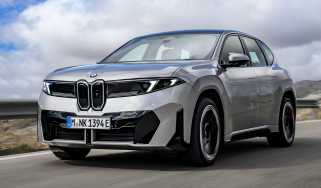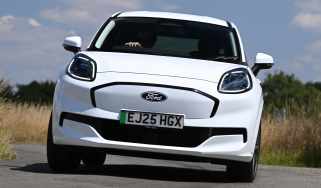New Suzuki e Vitara smashes the Skoda Elroq and Kia EV3 on price
The compact Suzuki e Vitara electric SUV is priced from a whisker under £30,000, and comes with the option of all-wheel drive
Prices for the Suzuki e Vitara have been revealed, with the base-spec front-wheel-drive model fitted with the smaller of the two batteries starting from £29,999. A top-spec, all-wheel-drive ‘Ultra’ with all the bells and whistles and the bigger battery, costs £37,799.
Just one variant will be available with the entry-level 49kWh battery. Every other version will come with the larger 61kWh unit, good for up to 248 miles of range. A basic Motion-spec car with the 61kWh battery costs £32,999, while adding Suzuki’s ALLGRIP-e all-wheel-drive system adds £2,000 to the price. Upgrading to Ultra trim costs £2,800 on both the Motion and Ultra trim.
Suzuki has said it will offer zero per cent finance at launch, payable over two years with a 20 per cent deposit. That means the bigger-battery, front-wheel drive model in Motion trim is available from £379 per month. Further to this, customers ordering before the end of September will get a free Ohme home wallbox, plus 10,000 miles of home-charging credit.
Available to order from July, Suzuki hasn’t yet revealed full specifications for the two trim levels. However, following a brief drive earlier this year on closed roads, there’s plenty we already know about the firm’s first electric car.
Suzuki e Vitara specs
Designed to rival models such as the Kia EV3, Skoda Elroq and many others, this is not a pure-electric version of the existing, hybrid-powered Suzuki Vitara. At 4,275mm long and with a wheelbase of 2,700mm, the e Vitara is 100mm longer than its sibling and there’s an extra 200mm between the wheels, which will help provide more interior space.
The new EV is wider and taller as well, but unsurprisingly, it’s also much heavier. The lightest version weighs in at 1,702kg, while the top-spec, dual-motor car tips the scale at close to 1,900kg. The combustion-powered Vitara on the other hand is between 1,075kg and 1,325kg, depending on the model.
The design of the e Vitara is based on the Suzuki eVX concept that was revealed in January 2023, with both cars featuring angular wheelarches, a gently sloping roofline, extensive use of plastic cladding for an SUV-esque look and a ‘three-point matrix’ lighting signature at the front and rear. A choice of 18 and 19-inch alloy wheels will be offered.
The e Vitara appears to have slightly more complex body surfacing than the concept though, with lots of creases, and no faux-skid plate sections on the bumpers, just all black plastic. The original concept’s flush door handles didn’t make it either, with the road-going model using conventional door handles instead up front, and the rear ones are concealed in the C-pillar. The charging port is above the front-left wheelarch.
Interior and practicality
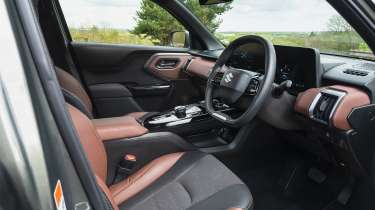
The concept’s interior design has been toned significantly for the e Vitara, but there are a few similarities in the layout and it certainly looks more modern than the cabin of the existing Vitara. Behind the two-spoke steering wheel is a 10.25-inch fully digital driver’s display, housed in the same panel as the 10.1-inch central infotainment screen, mounted high up on the dashboard.
Other features include a small row of physical climate controls located on the dash, and a floating centre console with the rotary gear selector from the Toyota bZ4X, a wireless charging pad and cup-holders on top, and a large storage area underneath, plus charging ports.
We got the chance to look around the Suzuki e Vitara during its official unveiling, and weren't bowled over by the amount of practicality on offer. The floor in the rear, while flat, is quite high so taller adults might not find it terribly comfortable back there on long journeys. The door bins are just about big enough for a small water bottle, though there are, at least, a pair of charging ports and two sets of ISOFIX child-seat mount points.
The 306-litre boot also falls short of what we’d expect from an SUV this size, because even the much smaller Jeep Avenger offers 355 litres of luggage capacity. The Suzuki does feature a 60:40-split sliding rear bench that can be pulled forward by approximately 20cm, however, due to the high boot floor, the most luggage space the e Vitara can offer is around 320 litres.
Range, battery and four-wheel drive
The e Vitara sits on a newly developed, EV-dedicated platform called ‘Heartect-e’ that Suzuki jointly developed with Toyota and Daihatsu. Certain technical details have yet to be announced, but we do know a heat pump will be fitted as standard and two battery sizes will be available: 49kWh and 61kWh.
We’re told the larger unit will only provide 248 miles (400km) of range. For context, in the right guise, the EV3 and Elroq both have a maximum range of more than 370 miles. Meanwhile, despite a claimed maximum charging speed of 150kW, the e Vitara takes around 30 minutes to charge from 15 to 70 per cent.
The entry-level e Vitara will use the 49kWh battery and a front-mounted electric motor that produces 142bhp and 189Nm of torque. This version will probably offer close to 200 miles of range from a single charge.
The mid-range e Vitara gets the larger 61kWh powerpack, plus a 172bhp e-motor that drives the front wheels. Meanwhile, the top-spec Suzuki combines the same battery with two e-motors – one on each axle – that deliver 181bhp, 300Nm of torque and four-wheel drive.
Suzuki claims its new ALLGRIP-e system provides “powerful performance”, and it adds a Trail mode for rough terrain and slippery conditions. It can apply the car’s brakes on spinning wheels while also sending torque to the opposite wheel to improve traction, which should have a similar effect to a limited-slip differential.
A stronger regenerative braking mode is activated via a button on the centre console, and the usual Normal, Eco and Sport drive modes are available, too.
Suzuki’s first EV is also Toyota’s next EV
Suzuki is also going to share the e Vitara with Toyota, which has launched its own, slightly different-looking small electric SUV called the Urban Cruiser. It is the second electric model in the maker’s passenger-car range (excluding the van-based Proace City Verso) after the bZ4X, but will be joined by the C-HR EV soon.
Toyota and Suzuki have been working together since 2016, and in the UK, the Toyota Corolla Touring Sports and RAV4 PHEV have been sold as the Suzuki Swace and Across respectively.
Now you can buy a car through our network of top dealers around the UK. Search for the latest deals…
Find a car with the experts


